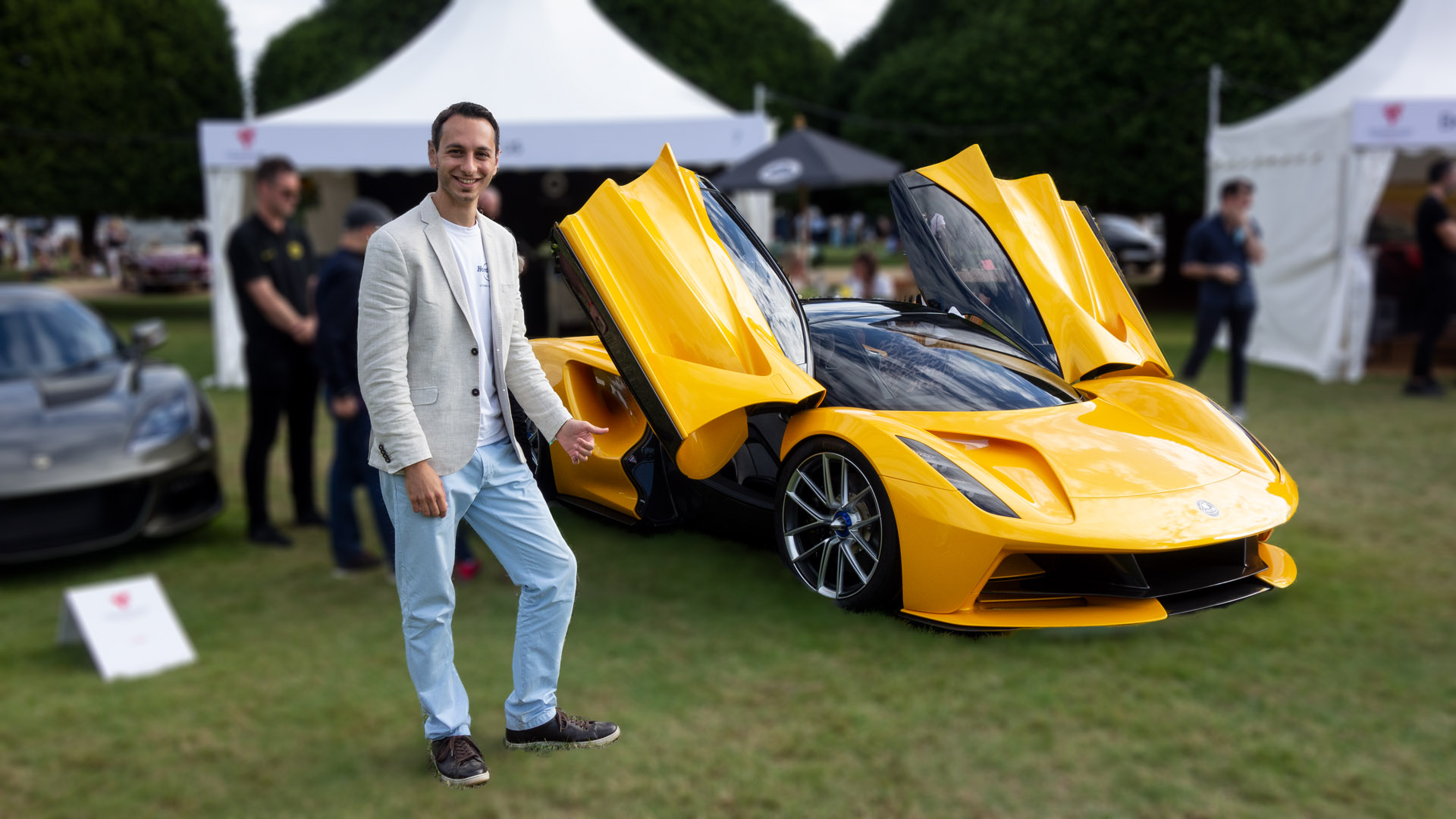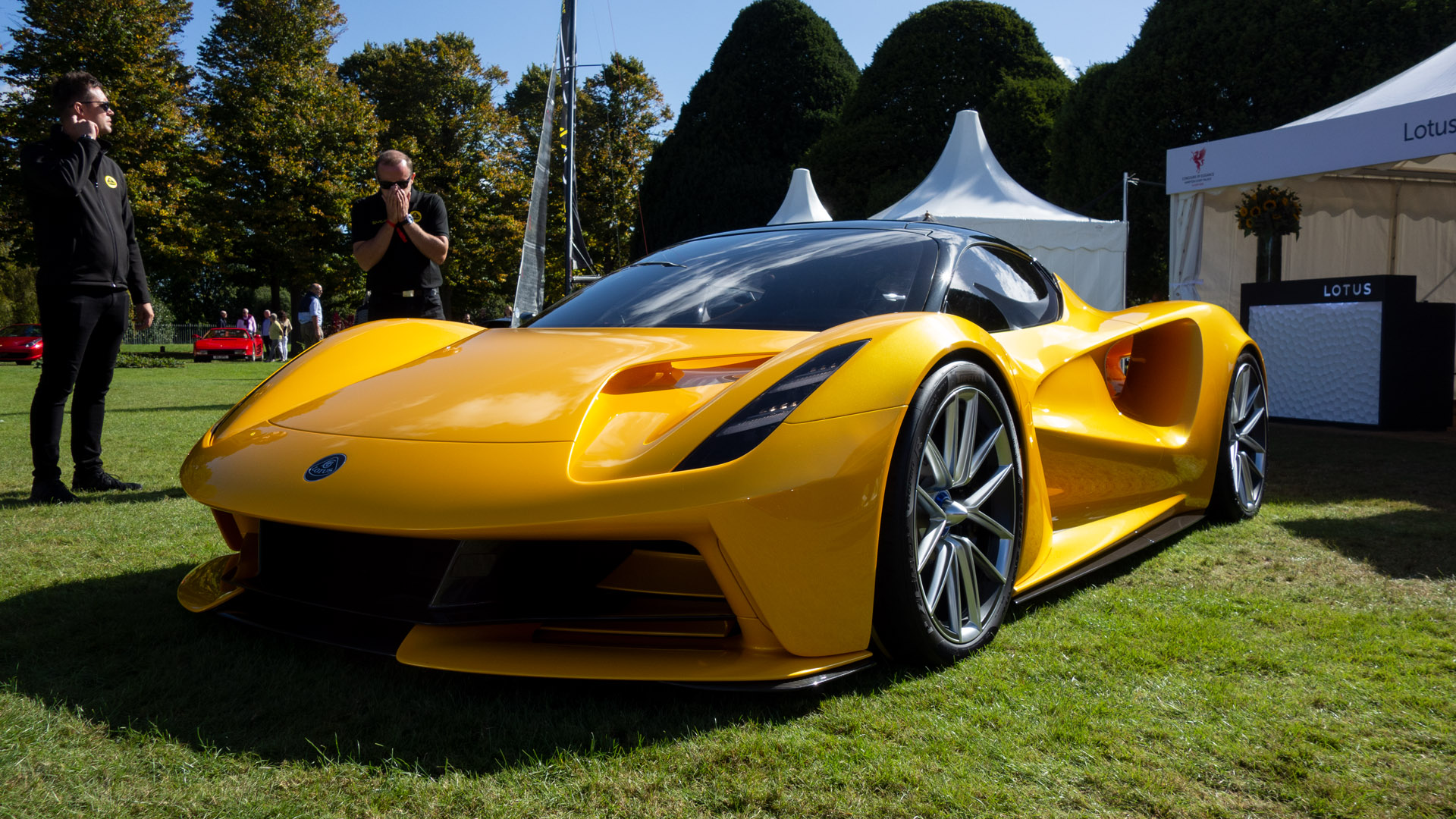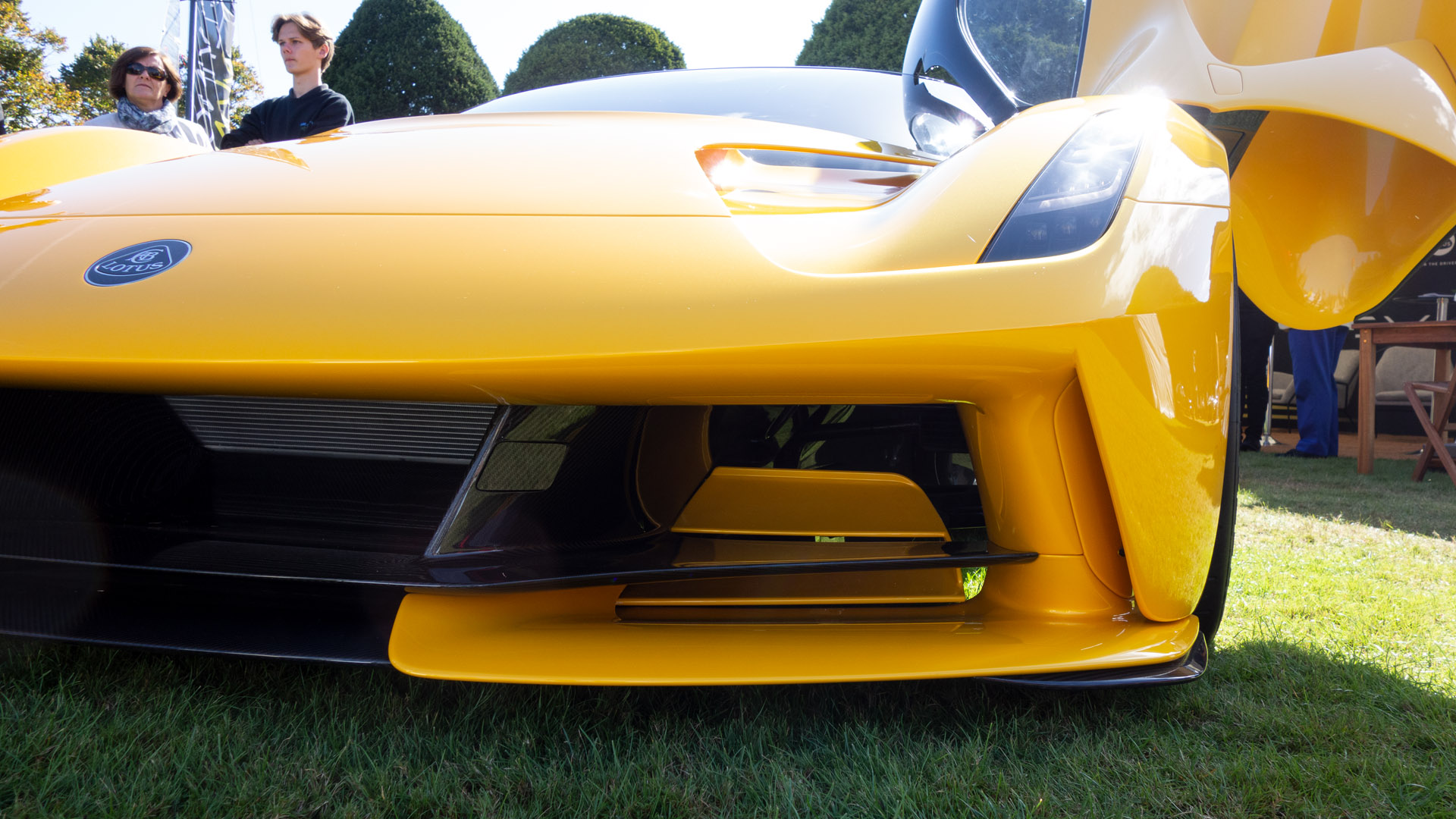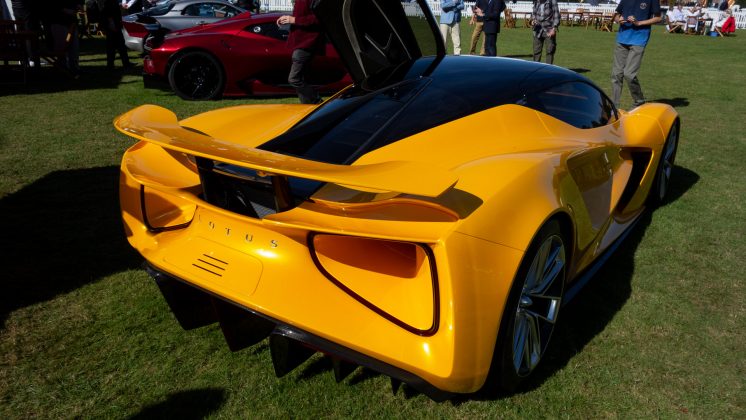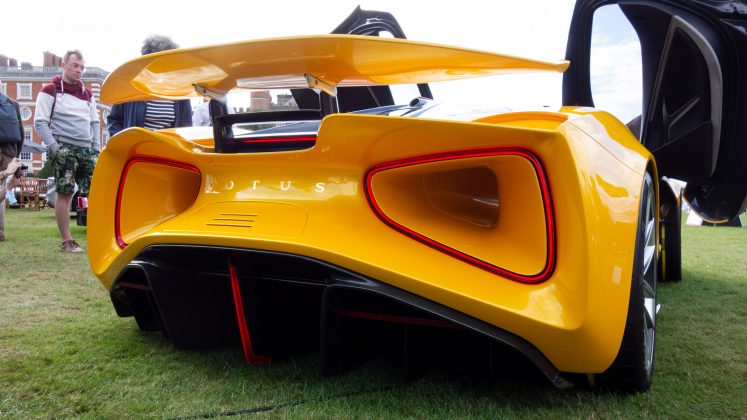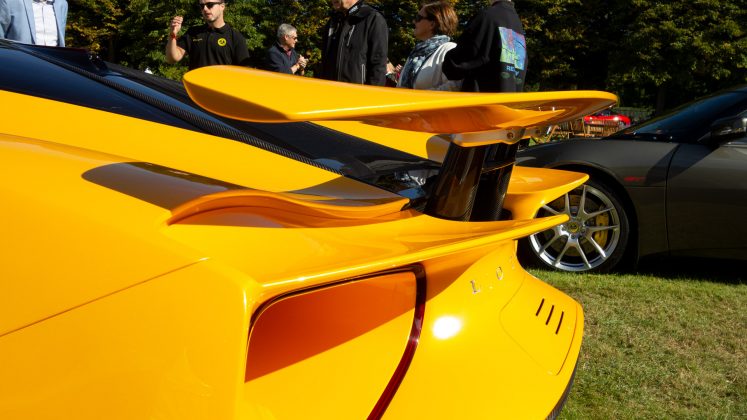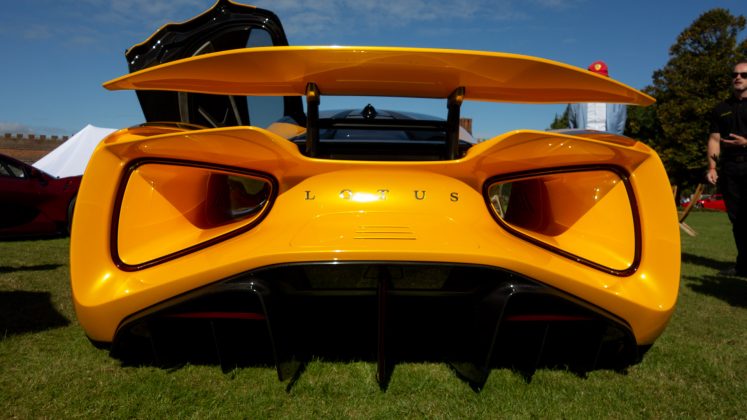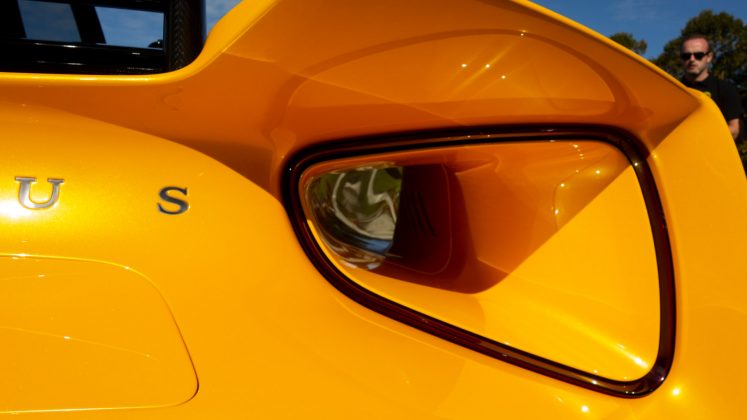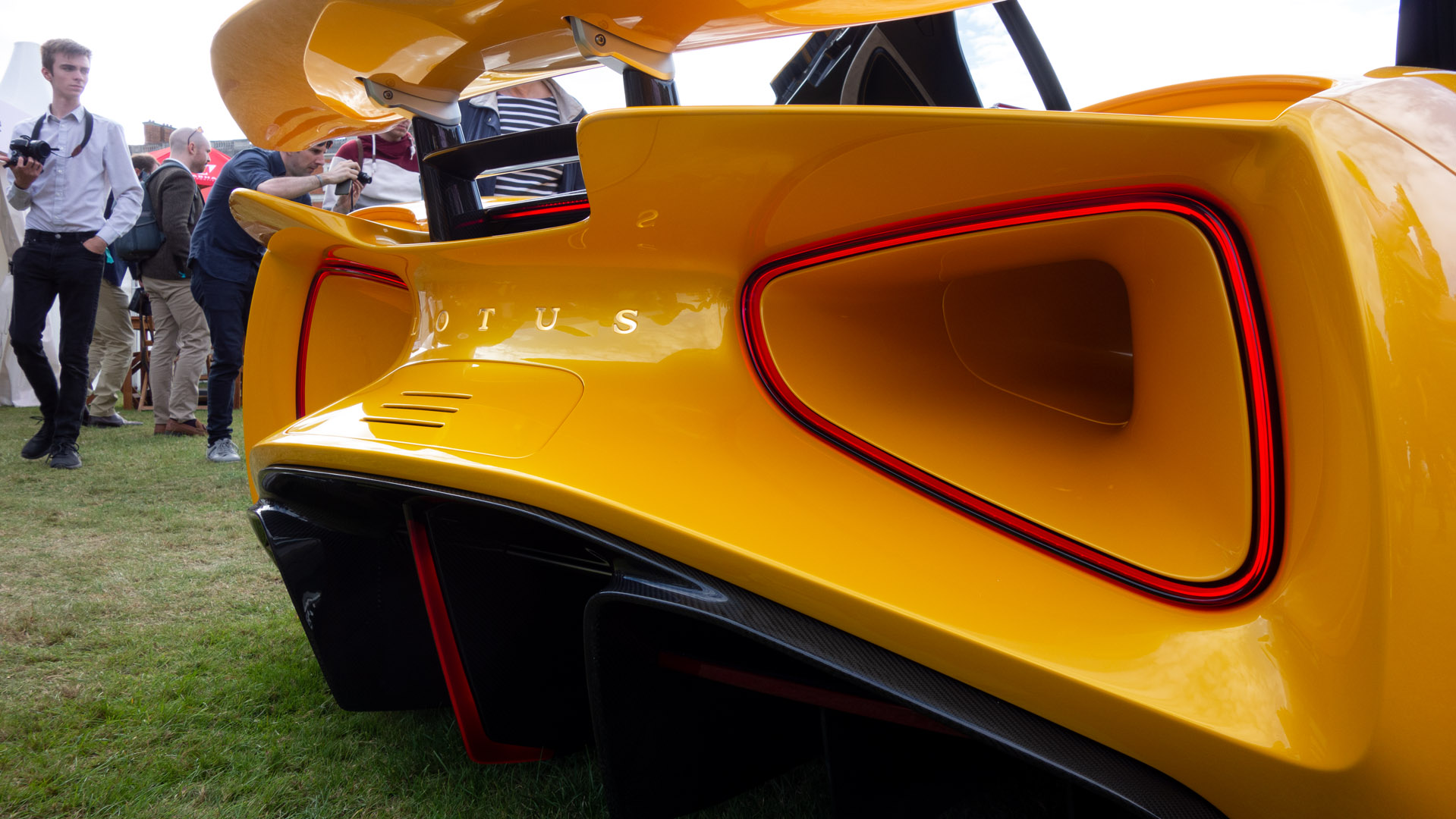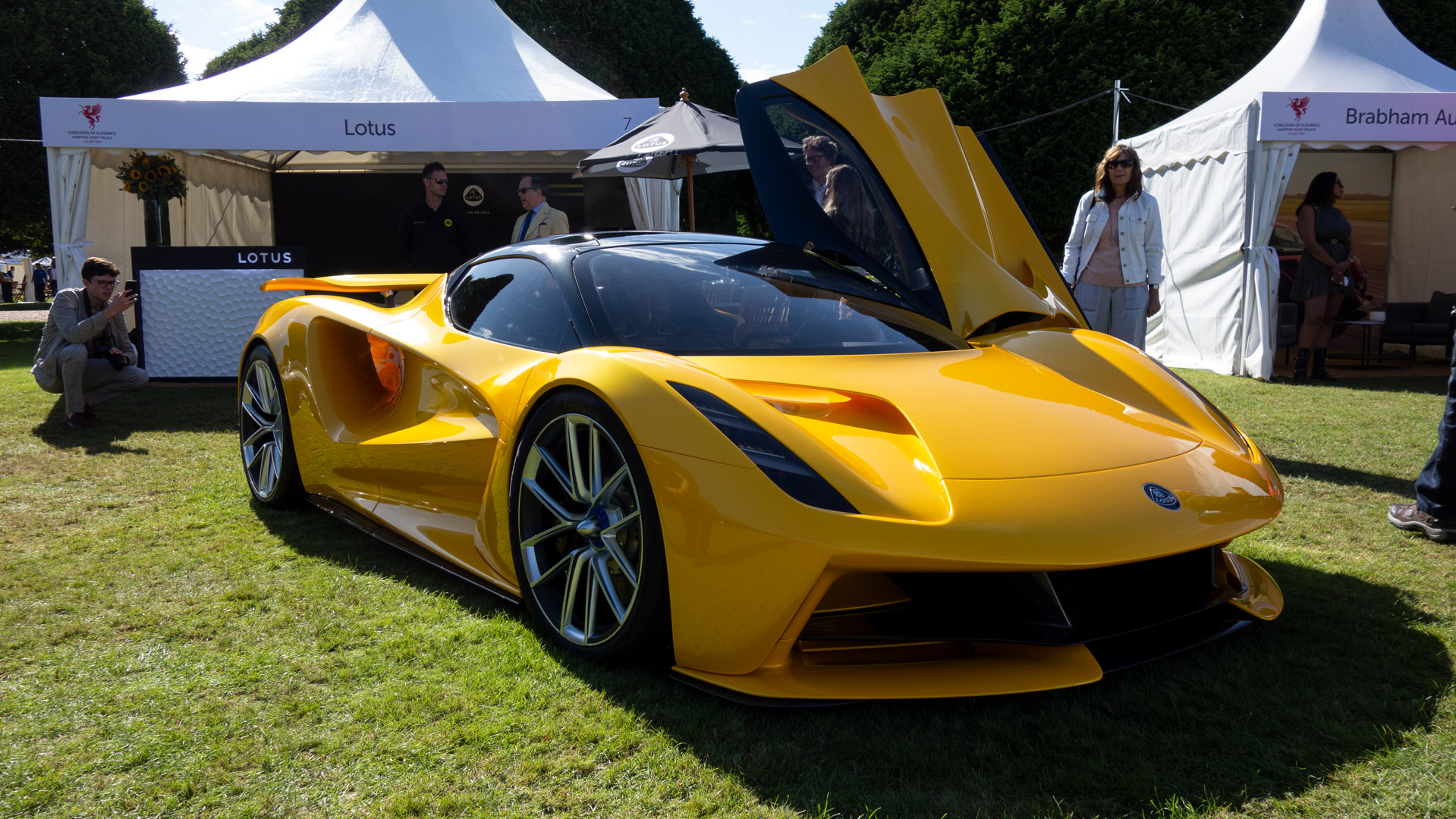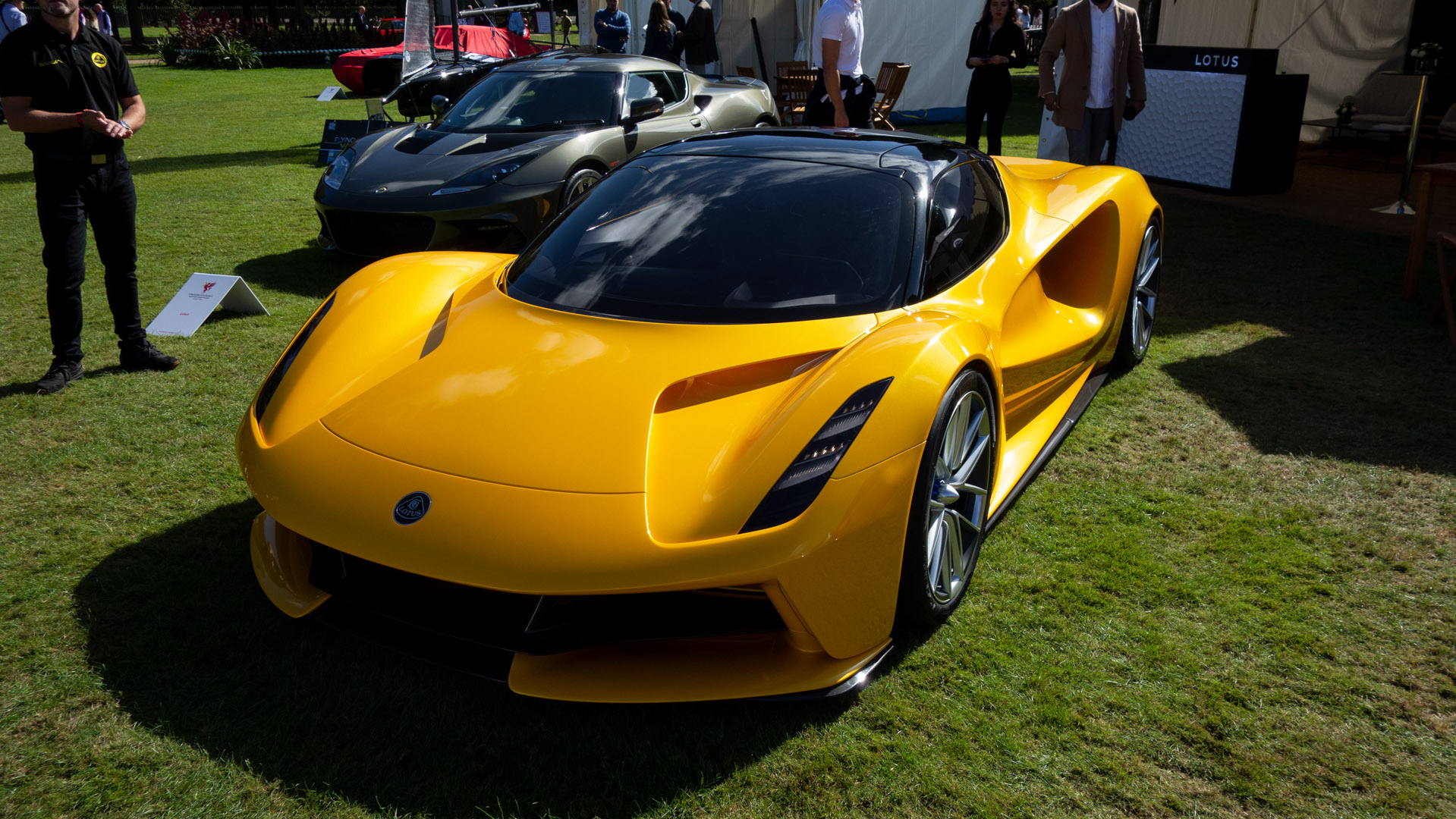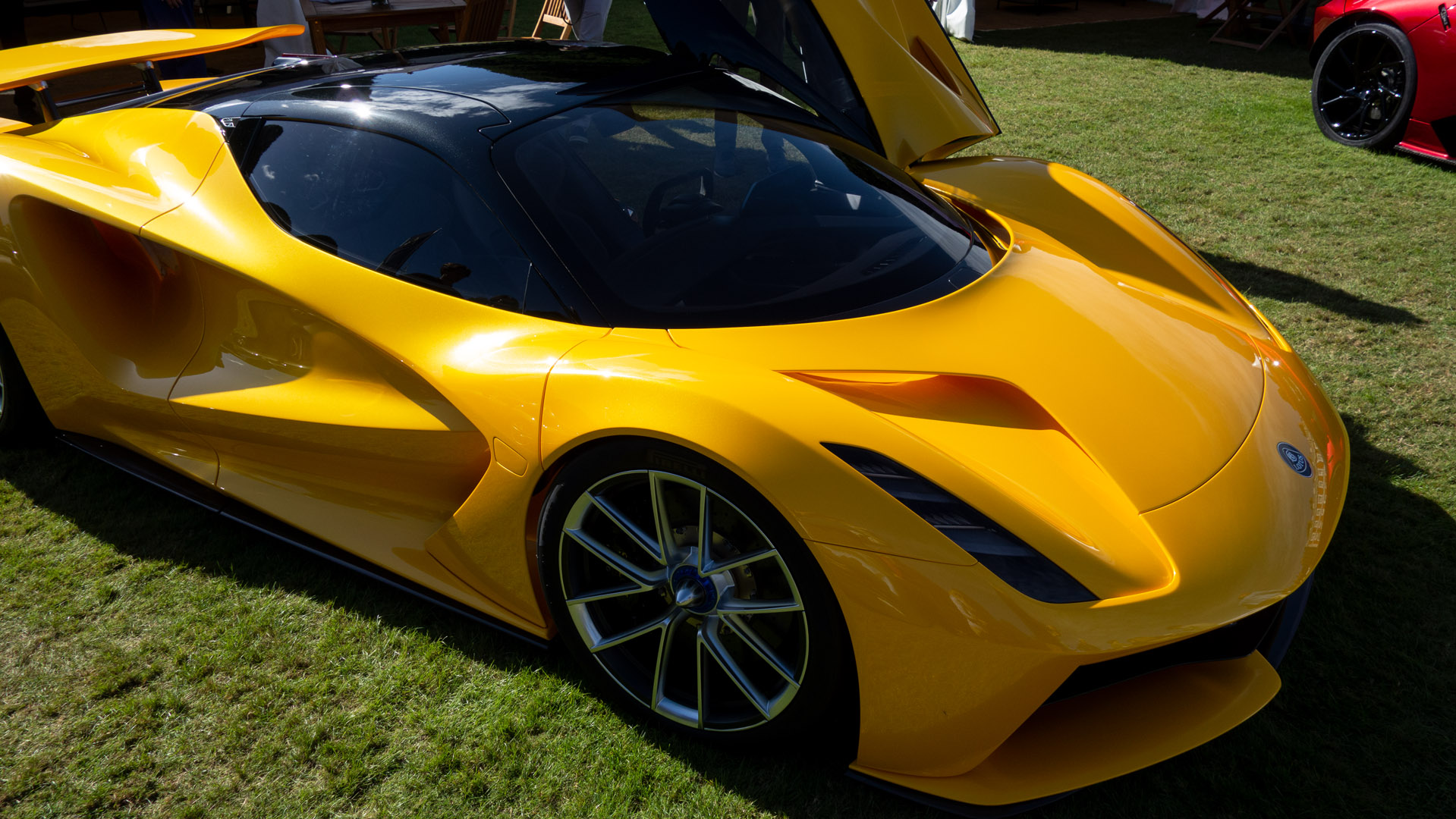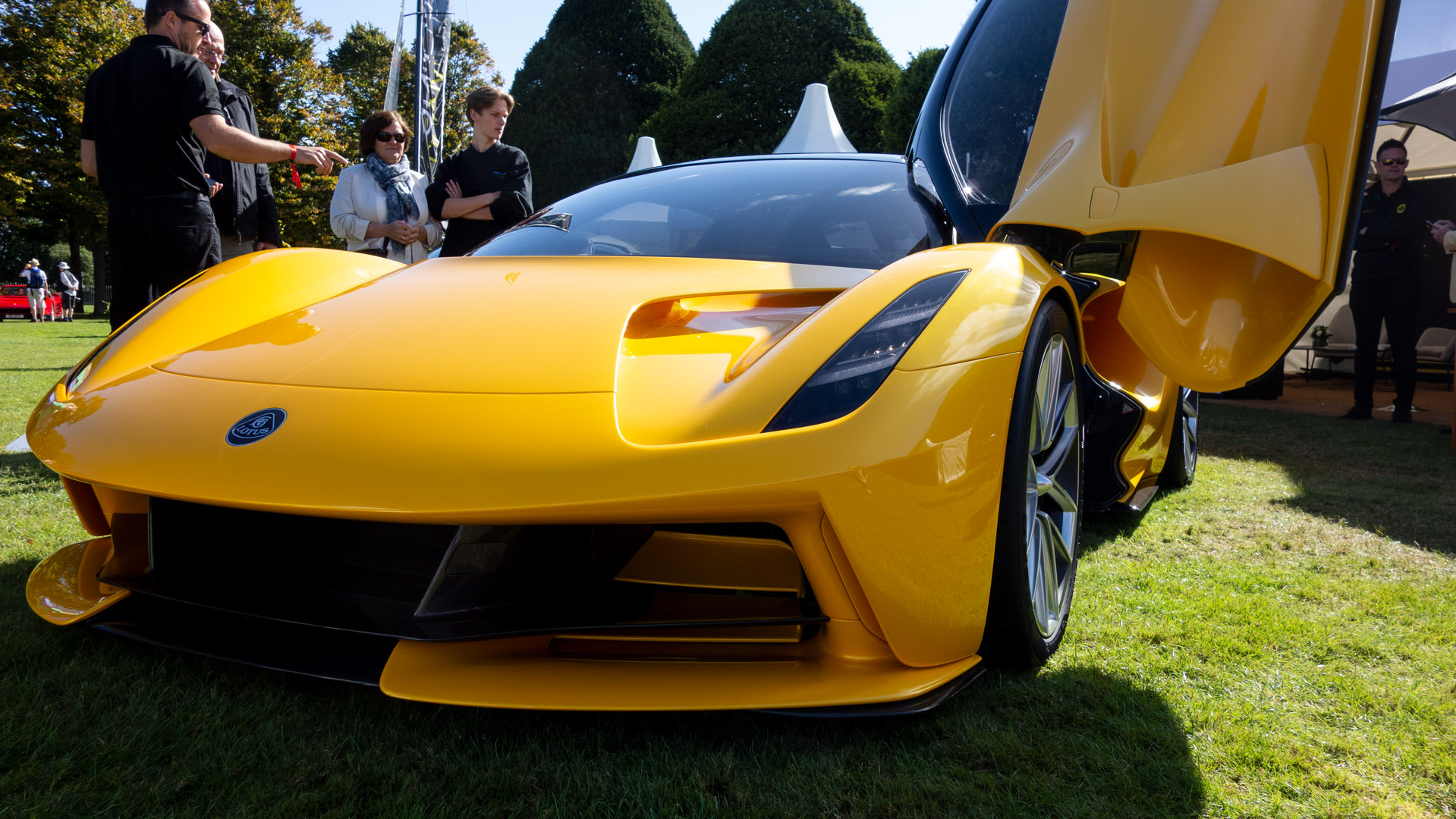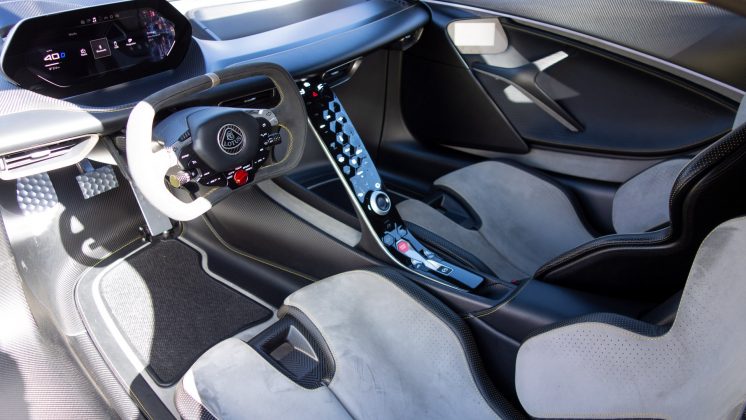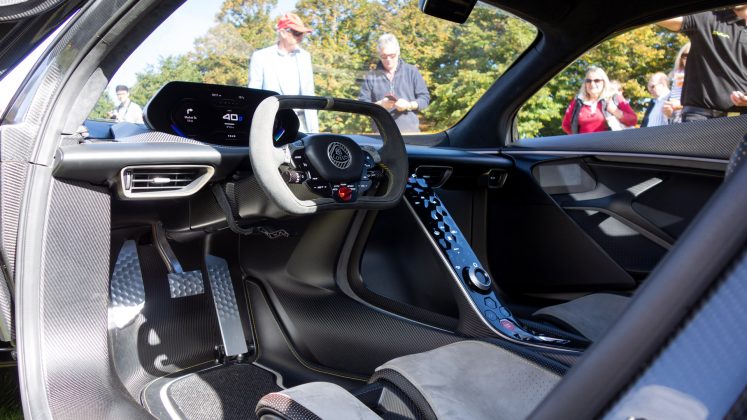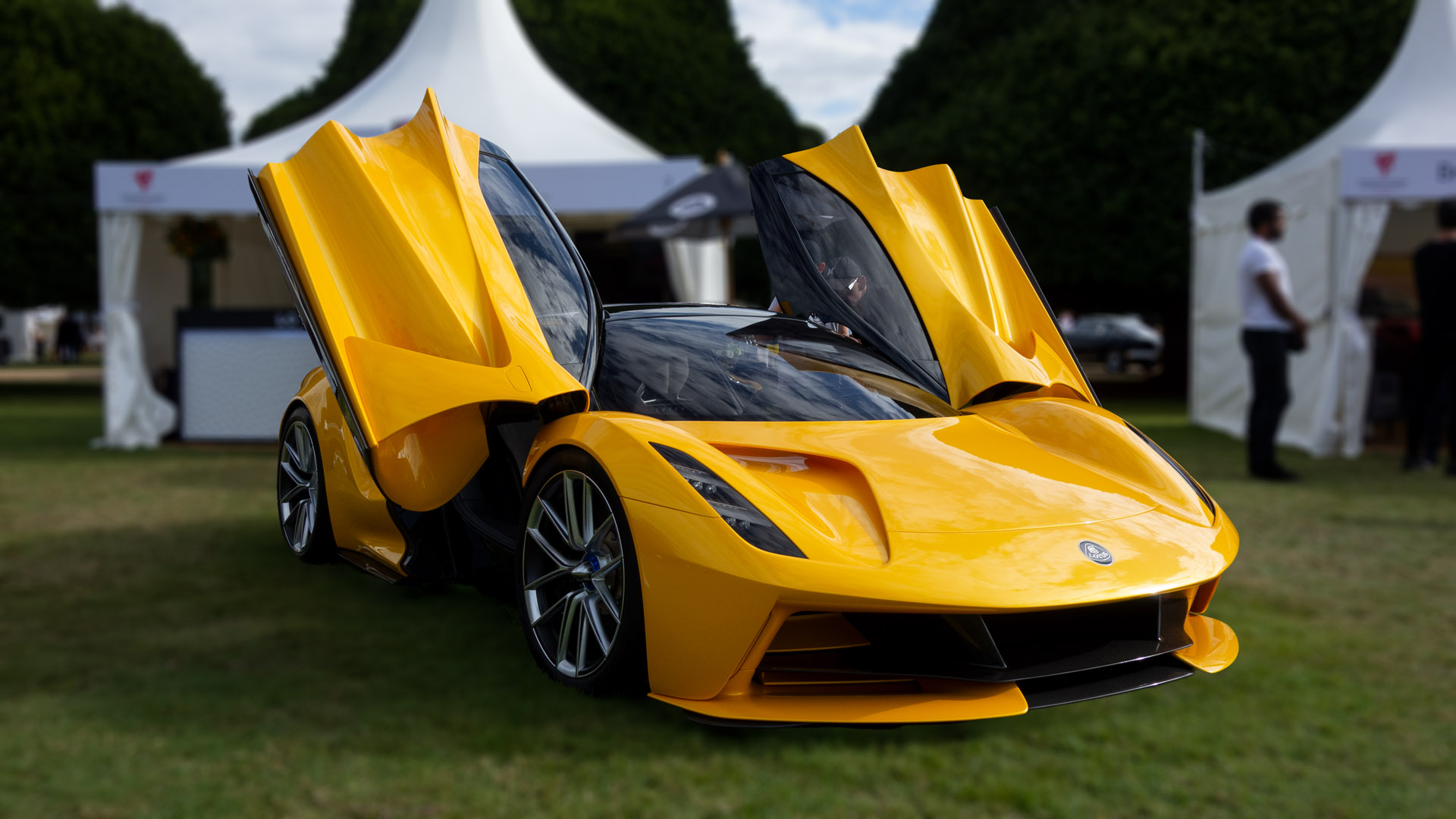The Lotus Evija is the first fully-electric British hypercar. With unparalleled performance and a target power output of 2,000 PS, it sets new standards in terms of advanced EV engineering. Quite simply, the Lotus Evija is the most powerful series-production road car ever built. As a name, Evija (pronounced ‘E-vi-ya’) means ‘the first in existence’ or ‘the living one’.
The Evija marks the start of an exciting new chapter in the history of the British sports car brand. It is the first hypercar from Lotus, and the company’s first model with an electrified powertrain. As the first completely new car to be launched under the stewardship of Geely – the world’s fastest-growing automotive group – its significance cannot be overstated.
TotallyEV got a first look of the Lotus Evija at the Concours of Elegance, which took place at Hampton Court Palace between 4-6 September 2020 – you can watch a video of the hypercar on our YouTube channel, too.
Read next: Audi A8 L TFSIe review: The best luxury plug-in hybrid?
Lotus Evija production units
Exclusivity and desirability go hand in hand in the world of hypercars, and the Evija is blessed with an abundance of both. Production is limited to not more than 130 examples, making it among the most exclusive cars ever launched. It’s a figure set in tribute to the car’s project code, Type 130. Lotus road and race cars throughout the brand’s seven decades of success have been assigned a Type number, and the Evija is no exception.
Hethel, close to the historic city of Norwich in the East of England, UK, has been the home of Lotus since 1966. The company has confirmed the production of the Evija will begin there during 2020.
As well as tempting the world’s hypercar buyers, the car will act as a halo for the rest of the Lotus range – the renowned Elise, Exige and Evora. It will do the same for a range of eagerly anticipated new Lotus performance models to come.
Buy a car phone mount on Amazon (Affiliate)
Lotus Cars CEO Phil Popham said: “The Lotus Evija is a car like no other. It will re-establish our brand in the hearts and minds of sports car fans and on the global automotive stage. It will also pave the way for further visionary models.
“This is another amazing moment in the history of our company. The Evija is a true Lotus in every sense – it has been developed with an unwavering passion to push boundaries, to explore new ways of thinking and to apply ground-breaking technologies.”
Lotus Evija design
A stunning piece of contemporary automotive design, the Evija features a dramatic Venturi tunnel through each rear quarter, giving it a truly breath-taking presence.
Russell Carr, Design Director, Lotus Cars, said: “We studied how Le Mans race cars use air flow creatively to go over, under and around the vehicle, but also through it. This concept of ‘porosity’ is key to the Evija and has enabled us to create a timeless design with exceptional amounts of downforce.”
The Evija signals the start of a contemporary new design language for Lotus, which will evolve and reappear on future high-performance cars.
Read next: MG ZS EV review: An affordable all-electric SUV
Illustrative of the innovative thinking and ingenuity which has always been part of the Lotus DNA, the Evija is a technical tour de force. It continues the legendary Lotus bloodline that’s rich in firsts and technical game-changers, both in the automotive and motorsport sectors. While it is a glimpse of the future from Lotus, it remains true to the company’s DNA and the guiding principles of founder Colin Chapman, who built the first Lotus in 1948.
The Evija is the first Lotus road car to feature a one-piece carbon fibre monocoque chassis. The cabin, from the fully adjustable race-style seats to the multi-function steering wheel, is the very pinnacle of motorsport-inspired road car design and technology.
The most striking element of the Lotus Evija is its exterior. From every angle the full carbon fibre bodywork is stretched taut, appearing shrink-wrapped over the mechanical components. Crouching low to the ground, with a ride height of just 105 mm, the pronounced muscular haunches envelop the teardrop cabin that sinks between them.
Read next: Formula E: Everything you need to know including the race calendar
Lotus Evija aerodynamics
The absence of traditional door mirrors plays a part in reducing drag. Cameras integrated into the front wings are electronically deployed on unlock, while another camera built into the roof provides a central view. Images are displayed on three interior screens.
Aside from creating a breath-taking presence, this design concept – known as ‘porosity’ – aids the delivery of high-energy air flow to the rear of the car. This in turn counteracts the low pressure behind the car to reduce drag. Furthermore, the Venturi effect inside the tunnels pulls air through the rear wheel arch louvres, maintaining air quality in the diffuser.
Active aerodynamics are deployed in the form of a rear spoiler, which elevates from its resting position flush to the upper bodywork, and an F1-style Drag Reduction System (DRS). Both are deployed automatically in Track mode, though can be deployed manually in other modes.
Another key feature of the Evija’s sophisticated aerodynamic system is the bi-plane front splitter. It’s another illustration of form and function working perfectly in tandem. Designed in three sections, the larger central area provides air to cool the battery pack – mid-mounted behind the two seats – while the air channelled through the two smaller outer sections cools the front e-axle. Lotus aficionados may notice a respectful nod to the iconic Type 72 Formula 1 car, with its square front central section and two side wings.
When viewed from the rear of the car, each tunnel is edged with a red LED to create a striking ribbon-style light signature. The result is a stunning visual effect that’s akin to the afterburners on a fighter jet, especially when seen at night. As an extra detail, an LED hidden within each tunnel illuminates its interior.
Read next: Extreme E: The electric off-road racing series
Lotus Evija battery & charging
The directional indicators are incorporated into the corners of the ribbon, while the reversing light is provided by the illuminated ‘T’ of the ‘LOTUS’ wordmark above the integrated charging flap.
Here, the hypercar will boast the world’s fastest charging battery. Thanks to the partnership with Williams Advanced Engineering, the battery has the ability to accept an 800kW charge. Although charging units capable of delivering this are not yet commercially available, when they are it will be possible to fully replenish the battery in just nine minutes.
The battery pack is mid-mounted immediately behind the two seats and supplies energy directly to four powerful e-motors. This highly efficient system is the lightest, most energy-dense, electric power package ever fitted to a road car. With a target weight of just 1,680 kg, it will be the lightest pure-electric hypercar ever to go into series production.
Using existing charging technology – such as a 350kW unit, which is currently the most powerful available – the Evija’s charge time will be 12 mins to 80% and 18 mins to 100%. The car’s range is 250 miles (400 km) on the WLTP Combined Cycle, or 270 miles on the NEDC Combined Cycle. Lotus is in discussions with external suppliers on a charging solution for customers.
The CCS2 charging socket is hidden behind a vented flap at the rear of the car. In the same location is a small plaque, reminding customers of the Britishness of the Evija.
Read next: What is an EV? Everything you need to know about hybrid and electric vehicles
Lotus Evija performance
With target figures of 2,000 PS of power and 1,700 Nm of torque, the Lotus Evija is the world’s most powerful production road car. Power is fed from the battery pack to four independently controlled high-power density e-motors. These feature integrated silicon carbide inverters and an epicyclic transmission on each axle of the four-wheel-drive powertrain. The motors and inverters are supplied by Integral Powertrain Ltd.
Four exceptionally compact, extremely light and highly efficient single-speed, helical gear ground planetary gearboxes transfer power to each driveshaft. Measuring 100mm in depth, each gearbox comes packaged with the e-motor and inverter as a single cylindrical Electrical Drive Unit (EDU). With a target power of 500 PS per e-motor, this is the most efficient and elegant engineering solution to deploying so much power with precision.
The Lotus Evija is equipped with ESP stability control to ensure safety in all road conditions, with further grip provided by the four-wheel drive system. A pure steering feel – a vital ingredient of every Lotus – is assured via an electro-hydraulic system.
The Evija has five driving modes – Range, City, Tour, Sport and Track. It can race from 0-62 mph (0-100 km/h) in under three seconds and accelerate to a top speed of more than 200 mph (0-320 km/h) in under 9 seconds.
Power can also be delivered over a sustained period. The car’s advanced aerodynamics and four-radiator cooling package keep the battery at an optimum temperature. It means that the Evija is capable of being driven flat-out with no derate for at least seven minutes in Track mode.
Matt Windle, Executive Director, Sports Car Engineering, Lotus Cars, said: “Every element of the Evija has been meticulously analysed and validated. Precision engineering is nothing without human engagement, and that’s why technology with soul is the benchmark for this and every Lotus.”
Read next: Renault Megane E-Tech first drive: A £30,685 plug-in hybrid estate
Lotus Evija technology
As a pure EV, the Evija will be ultra-quiet at low speeds. During this time regulations require that it emits a digitally created sound – transmitted via a front-mounted speaker – which will alert pedestrians to its presence.
Inside, the cabin strikes the perfect balance between the precise functionality of a track car and the comfort of a road car. The driving position is fully adjustable to accommodate the greatest range of occupants. The elegant carbon fibre shell seats are hand-trimmed with thick Alcantara-finished pads, and feature manual fore/aft adjustment plus electric back operation. The steering column is manually adjustable for both rake and reach. Three-point seatbelts are fitted as standard, with four-point harnesses an option. Built into the bodyshell, close to the occupants’ hip point, are two bespoke storage areas.
The design of the steering wheel, similar to that found in an LMP or F1 car, further reinforces the Evija’s sporting intentions. The outer ring is finished in Alcantara as standard with leather available as an option. Buttons are grouped in an intuitive manner and govern functions including phone use, cruise control and DRS deployment.
Ahead of the steering wheel is a state-of-the-art digital display, providing the driver with key information such as mode, battery charge and remaining range. It is the car’s only screen, putting all necessary information in one place. The screen displays essential functions only, with information appearing as required when the appropriate button is pushed, then fading when no longer needed.
Climate control and a premium infotainment system are fitted as standard. Customers can seamlessly integrate their smartphones via Apple CarPlay and Android Auto, accessing their own music and navigation.
Buy a car phone mount on Amazon (Affiliate)
The Evija is the first Lotus to provide drivers with a full suite of digital connected infotainment, which will benefit from over-the-air software updates. A powerful onboard modem enables communication to the cloud, and the driver can interact with that data through a Lotus smartphone app. The app will enable drivers to monitor their Evija from anywhere in the world, for example, to check the battery charge status and driving range. It will also support remote use of air-con, to heat or cool the cabin ahead of the next drive.
The Evija’s infotainment system includes a chronograph to allow the driver to record their lap times. Connection to the cloud means they can view their performance while at the track and recall previous sessions through the app.
Order books are now open through Lotus’ website; the hypercar starts from £2.2 million. Let us know what you make of the Lotus Evija in the comments section below or via social media – we’re on: YouTube, Instagram, Facebook, Twitter and LinkedIn.

